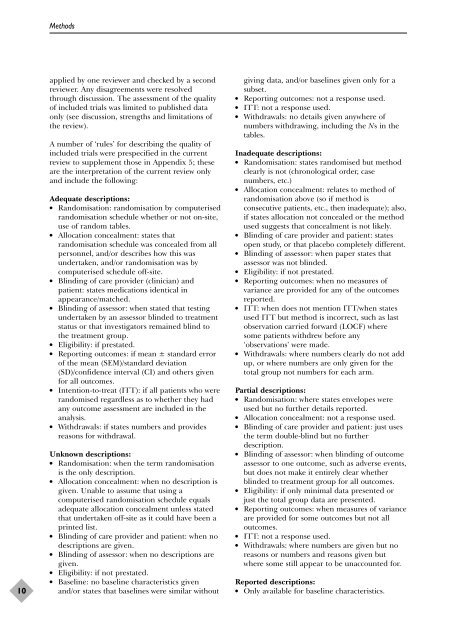Donepezil, rivastigmine, galantamine and memantine for ...
Donepezil, rivastigmine, galantamine and memantine for ...
Donepezil, rivastigmine, galantamine and memantine for ...
You also want an ePaper? Increase the reach of your titles
YUMPU automatically turns print PDFs into web optimized ePapers that Google loves.
10<br />
Methods<br />
applied by one reviewer <strong>and</strong> checked by a second<br />
reviewer. Any disagreements were resolved<br />
through discussion. The assessment of the quality<br />
of included trials was limited to published data<br />
only (see discussion, strengths <strong>and</strong> limitations of<br />
the review).<br />
A number of ‘rules’ <strong>for</strong> describing the quality of<br />
included trials were prespecified in the current<br />
review to supplement those in Appendix 5; these<br />
are the interpretation of the current review only<br />
<strong>and</strong> include the following:<br />
Adequate descriptions:<br />
● R<strong>and</strong>omisation: r<strong>and</strong>omisation by computerised<br />
r<strong>and</strong>omisation schedule whether or not on-site,<br />
use of r<strong>and</strong>om tables.<br />
● Allocation concealment: states that<br />
r<strong>and</strong>omisation schedule was concealed from all<br />
personnel, <strong>and</strong>/or describes how this was<br />
undertaken, <strong>and</strong>/or r<strong>and</strong>omisation was by<br />
computerised schedule off-site.<br />
● Blinding of care provider (clinician) <strong>and</strong><br />
patient: states medications identical in<br />
appearance/matched.<br />
● Blinding of assessor: when stated that testing<br />
undertaken by an assessor blinded to treatment<br />
status or that investigators remained blind to<br />
the treatment group.<br />
● Eligibility: if prestated.<br />
● Reporting outcomes: if mean ± st<strong>and</strong>ard error<br />
of the mean (SEM)/st<strong>and</strong>ard deviation<br />
(SD)/confidence interval (CI) <strong>and</strong> others given<br />
<strong>for</strong> all outcomes.<br />
● Intention-to-treat (ITT): if all patients who were<br />
r<strong>and</strong>omised regardless as to whether they had<br />
any outcome assessment are included in the<br />
analysis.<br />
● Withdrawals: if states numbers <strong>and</strong> provides<br />
reasons <strong>for</strong> withdrawal.<br />
Unknown descriptions:<br />
● R<strong>and</strong>omisation: when the term r<strong>and</strong>omisation<br />
is the only description.<br />
● Allocation concealment: when no description is<br />
given. Unable to assume that using a<br />
computerised r<strong>and</strong>omisation schedule equals<br />
adequate allocation concealment unless stated<br />
that undertaken off-site as it could have been a<br />
printed list.<br />
● Blinding of care provider <strong>and</strong> patient: when no<br />
descriptions are given.<br />
● Blinding of assessor: when no descriptions are<br />
given.<br />
● Eligibility: if not prestated.<br />
● Baseline: no baseline characteristics given<br />
<strong>and</strong>/or states that baselines were similar without<br />
giving data, <strong>and</strong>/or baselines given only <strong>for</strong> a<br />
subset.<br />
● Reporting outcomes: not a response used.<br />
● ITT: not a response used.<br />
● Withdrawals: no details given anywhere of<br />
numbers withdrawing, including the Ns in the<br />
tables.<br />
Inadequate descriptions:<br />
● R<strong>and</strong>omisation: states r<strong>and</strong>omised but method<br />
clearly is not (chronological order, case<br />
numbers, etc.)<br />
● Allocation concealment: relates to method of<br />
r<strong>and</strong>omisation above (so if method is<br />
consecutive patients, etc., then inadequate); also,<br />
if states allocation not concealed or the method<br />
used suggests that concealment is not likely.<br />
● Blinding of care provider <strong>and</strong> patient: states<br />
open study, or that placebo completely different.<br />
● Blinding of assessor: when paper states that<br />
assessor was not blinded.<br />
● Eligibility: if not prestated.<br />
● Reporting outcomes: when no measures of<br />
variance are provided <strong>for</strong> any of the outcomes<br />
reported.<br />
● ITT: when does not mention ITT/when states<br />
used ITT but method is incorrect, such as last<br />
observation carried <strong>for</strong>ward (LOCF) where<br />
some patients withdrew be<strong>for</strong>e any<br />
‘observations’ were made.<br />
● Withdrawals: where numbers clearly do not add<br />
up, or where numbers are only given <strong>for</strong> the<br />
total group not numbers <strong>for</strong> each arm.<br />
Partial descriptions:<br />
● R<strong>and</strong>omisation: where states envelopes were<br />
used but no further details reported.<br />
● Allocation concealment: not a response used.<br />
● Blinding of care provider <strong>and</strong> patient: just uses<br />
the term double-blind but no further<br />
description.<br />
● Blinding of assessor: when blinding of outcome<br />
assessor to one outcome, such as adverse events,<br />
but does not make it entirely clear whether<br />
blinded to treatment group <strong>for</strong> all outcomes.<br />
● Eligibility: if only minimal data presented or<br />
just the total group data are presented.<br />
● Reporting outcomes: when measures of variance<br />
are provided <strong>for</strong> some outcomes but not all<br />
outcomes.<br />
● ITT: not a response used.<br />
● Withdrawals: where numbers are given but no<br />
reasons or numbers <strong>and</strong> reasons given but<br />
where some still appear to be unaccounted <strong>for</strong>.<br />
Reported descriptions:<br />
● Only available <strong>for</strong> baseline characteristics.
















